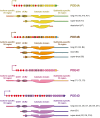Understanding PDE4's function in Alzheimer's disease; a target for novel therapeutic approaches
- PMID: 31642904
- PMCID: PMC6824677
- DOI: 10.1042/BST20190763
Understanding PDE4's function in Alzheimer's disease; a target for novel therapeutic approaches
Abstract
Phosphodiesterases (PDEs) have long been considered as targets for the treatment of Alzheimer's disease (AD) and a substantial body of evidence suggests that one sub-family from the super-family of PDEs, namely PDE4D, has particular significance in this context. This review discusses the role of PDE4 in the orchestration of cAMP response element binding signaling in AD and outlines the benefits of targeting PDE4D specifically. We examine the limited available literature that suggests PDE4 expression does not change in AD brains together with reports that show PDE4 inhibition as an effective treatment in this age-related neurodegenerative disease. Actually, aging induces changes in PDE4 expression/activity in an isoform and brain-region specific manner that proposes a similar complexity in AD brains. Therefore, a more detailed account of AD-related alterations in cellular/tissue location and the activation status of PDE4 is required before novel therapies can be developed to target cAMP signaling in this disease.
Keywords: Alzheimer's disease; cAMP; cyclic nucleotide phosphodiesterases.
© 2019 The Author(s).
Conflict of interest statement
The Authors declare that there are no competing interests associated with the manuscript.
Figures


References
-
- Bolger G., Michaeli T., Martins T., St John T., Steiner B., Rodgers L. et al. (1993) A family of human phosphodiesterases homologous to the dunce learning and memory gene product of Drosophila melanogaster are potential targets for antidepressant drugs. Mol. Cell Biol 13, 6558–6571 10.1128/MCB.13.10.6558 - DOI - PMC - PubMed
Publication types
MeSH terms
Substances
Grants and funding
- PG/17/26/32881/BHF_/British Heart Foundation/United Kingdom
- MC-PC-13063 /MRC_/Medical Research Council/United Kingdom
- MC_PC_15039/MRC_/Medical Research Council/United Kingdom
- MC-PC-15039/MRC_/Medical Research Council/United Kingdom
- BHF/TARGETPDE/PG/17/26/32881/BHF_/British Heart Foundation/United Kingdom
LinkOut - more resources
Full Text Sources
Medical

